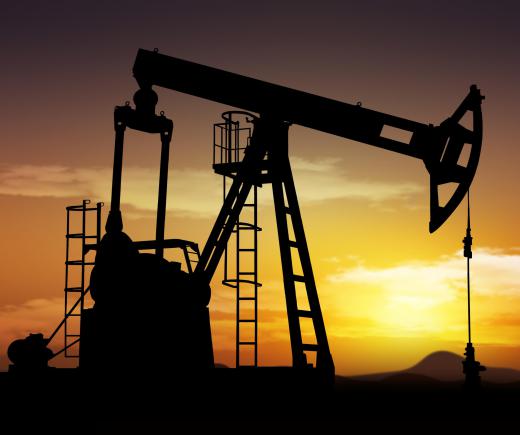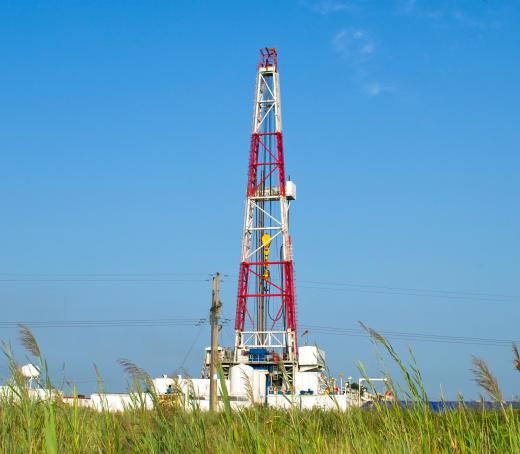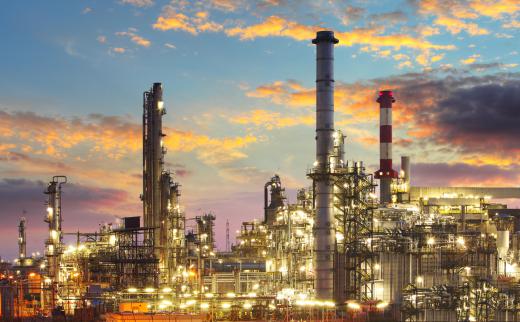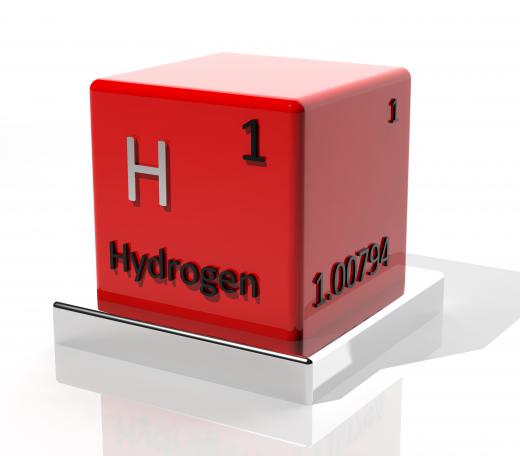What are Hydrocarbons?
 Michael Anissimov
Michael Anissimov
Hydrocarbons are organic chemical compounds that consist entirely of carbon and hydrogen, and range from simple molecules such as methane, to polymers such as polystyrene, which consists of thousands of atoms. The ability of carbon atoms to bond strongly to each other allows them to form an almost unlimited variety of chains, rings, and other structures that form the backbones of organic molecules. Since each atom can form four bonds, these backbones include other elements, such as hydrogen. The compounds are flammable, since the two elements they contain will combine easily with oxygen in the air, releasing energy. Fossil fuels, such as oil and natural gas, are naturally occurring mixtures of hydrocarbons; coal also contains some, although it is mostly just carbon.
Structure and Naming Conventions

The naming of hydrocarbons follows certain conventions, although in many cases, compounds may be better known under older names. In the modern system, the first part of the name represents the number of carbon atoms in the molecule: in ascending sequence, the first eight are prefixed meth-, eth-, prop-, but-, pent-, hex-, hept- and oct-. Compounds where the carbons are all joined by single bonds are known collectively as alkanes, and have names ending in –ane. Therefore, the first eight alkanes are methane, ethane, propane, butane, pentane, hexane, heptane and octane.

Carbon atoms can also form double or triple bonds with one another. Molecules that have double bonds are known as alkenes, and have names ending in –ene, while those that have triple bonds are called alkynes, and have names ending in -yne. Molecules that have only single bonds contain the maximum possible number of hydrogen atoms, and are therefore described as saturated. Where there are double or triple bonds, there are fewer places available for hydrogen, so these compounds are described as unsaturated.

To give a simple example, ethane has two carbons joined by a single bond, leaving each able to bond to three hydrogen atoms, so its chemical formula is C2H6 and it is an alkane. In ethene there is a carbon-carbon double bond, so it can only have four hydrogens, making it an alkene with the formula C2H4. Ethyne has a triple bond, giving it the formula C2H2, and making it an alkyne. This compound is better known as acetylene.

The carbon atoms can also form rings. Alkanes with rings have names beginning with cyclo-. Therefore, cyclohexane is an alkane with six carbon atoms joined by single bonds in such a way as to form a ring. A ring with alternating single and double bonds is also possible, and is known as a benzene ring. Hydrocarbons containing a benzene ring are known as aromatic, because many of them are pleasant-smelling.

Some hydrocarbon molecules have chains that branch. Butane, which normally consists of a single chain, can exist in a form where one carbon atom is bonded to two others, forming a branch. These alternative forms of a molecule are known as isomers. The branched isomer of butane is known as isobutane.
Production
Most production of hydrocarbons is from fossil fuels: coal, oil, and natural gas, which are extracted from the ground in quantities of millions of tons per day. Crude oil is mostly a mixture of many different alkanes and cycloalkanes, with some aromatic compounds. These can be separated from one another at oil refineries by distillation, because of their different boiling points. Another process that is used is known as “cracking”: catalysts are employed to break some of the larger molecules into smaller ones that are more useful as fuels.
Properties
Generally speaking, the more complex a hydrocarbon is, the higher its melting and boiling points. For example, the simpler types, such as methane, ethane, and propane, with one, two, and three carbons, respectively, are gases. Many forms are liquids: examples are hexane and octane. Solid forms include paraffin wax — a mixture of molecules with between 20 and forty carbon atoms — and various polymers consisting of chains of thousands of atoms, such as polyethylene.
The most notable chemical properties of hydrocarbons are their flammability and their ability to form polymers. Those that are gases or liquids will react with oxygen in the air, producing carbon dioxide (CO2) and water, and releasing energy in the form of light and heat. Some energy must be supplied to start the reaction, but once started, it is self-sustaining: these compounds will burn, as illustrated by lighting a gas hob with a match or spark. Solid forms will also burn, but less easily. In some cases, not all the carbon will form CO2; soot and smoke can be produced by some types when they burn in air, and in an insufficient supply of oxygen, any hydrocarbon can produce the toxic, odorless gas, carbon monoxide (CO).
Uses
The flammability of hydrocarbons makes them very useful as fuels, and they are the primary energy source for today’s civilization. Worldwide, most electricity is generated by the burning of these compounds, and they are used to propel practically every mobile machine: cars, trucks, trains, planes, and ships. They are also used in the manufacture of many other chemicals and materials. Most plastics, for example, are hydrocarbon polymers. Other uses include solvents, lubricants and propellants for aerosol cans.
Problems with Fossil Fuels
Hydrocarbons have been a very successful fuel source over the last two hundred years or so, but there are increasing calls to scale back their use. Their combustion produces smoke and soot, causing serious pollution problems in some areas. It also produces large amounts of CO2. There is widespread agreement among scientists that increasing levels of this gas in the atmosphere are helping to trap heat, raising global temperatures and changing the Earth’s climate.
In addition, fossil fuels will not last forever. Burning fuel at the current rate, oil could run out in less than a century and coal in several centuries. All of this has led to calls to develop renewable energy sources such as solar and wind power, and the construction of more nuclear power plants, which produce zero CO2 emissions. In 2007, the Nobel Peace Prize was awarded to former US Vice President Al Gore and the UN’s Intergovernmental Panel on Climate Change for their work in confirming and spreading the message that the combustion of hydrocarbons is largely responsible for global warming.
AS FEATURED ON:
AS FEATURED ON:















Discussion Comments
Why there are a lot of numbers of hydrocarbons?
Thank you. It was so helpful.
85 percent of all electricity worldwide is generated by the burning of hydrocarbons, and hydrocarbon fuel is used to propel practically every mobile machine: cars, trucks, trains, planes and ships.
How do you know if global warming is even real?
@ Glasshouse- The challenge of finding renewable sources of fuel is daunting, to say the least. According to the U.S. Energy Information Administration, global energy consumption amounts to about 500 quadrillion BTUs per year. The rate of consumption is growing at about 12 quadrillion BTUs per year. This may be a tough number to comprehend, but imagine 500 followed by 15 zeros.
If you translate this into gallons of gasoline, you would divide 500 quadrillion by 125,000 (the number of BTUs in a gallon of gas). That's the energy equivalent of 4 trillion gallons of gas. We have a long way to go.
@ Parmnparsley- There is no silver bullet to solving the energy crisis. The fact is there has never been a discovery as versatile as hydrocarbon chains. The fact that we can use one mined substance to create everything from energy, to plastics, to asphalt, and more is what makes coal and petroleum unique.
The solution is multiple solutions. Most of the renewable technologies we have available will only work in certain locations. Not all fuel crops will grow in all places, and not all places are sunny or windy.
The one thing we have going for us, is two centuries worth of technology based on fossil fuels. We already know how energy works; we just have to create renewable applications suitable for different regions, and then make them logistically compatible. The days of a universal fuel source are near over.
It is amazing to think that nearly all of the hydrocarbons the earth has sequestered in the last 4.5 billion years may be consumed by one species in a matter of a half millennium. Looking at it from that perspective it almost seems obvious that releasing that much carbon into the atmosphere would have dire repercussions.
We have become so addicted to hydrocarbons it makes me wonder if we will be successful at finding a substitute. Civilization has made so much progress in the last few centuries, and most of it is due to what we once thought was limitless energy.
What could replace coal and petroleum? Furthermore, how can we find a replacement for hydrocarbons when everyone is researching different technologies?
Post your comments